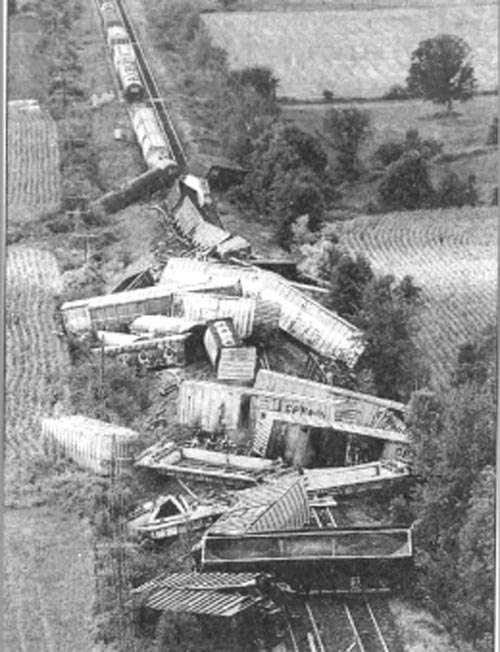Details of Railway Accidents in the Ottawa Area

1996, August 29 - 36 cars derail at mile 32.6, Dalhousie Mills, Canadian Pacific, Winchester subdivision. 200 evacuated

TSB report R96H0021

TRAIN SPLITTING: More than 200 people were forced from their homes Thursday when 30 cars of a CP Rail freight train overturned and a fire broke out 155 kilometres east of Ottawa.
One car leaked hydrogen peroxide. No one was injured.
| Ottawa Citizen 30 August 1996 Derailment, toxic leak force 200 to flee DALHOUSIE MILLS, Ont. In what is becoming an increasingly common event, a CP Rail freight train carrying dangerous chemicals derailed on the Ontario-Quebec border, 155 kilometres east of Ottawa, forcing more than 200 people from their homes for six hours. The derailment occurred at 11:40 a.m. Twisted wreckage straddled the border between Dalhousie Mills, Ont.and Dalhousie, Que. This was the 161st train to jump the tracks this year in Canada the most in a single year since 1985. No one was injured in the crash, which saw 36 cars at the back of the two-engine, 69-car train break away from the front and plow into each other over a 400-metre stretch of CP Rail's mainline. Three of the cars were carrying chemicals. Two carrying alcohol remained upright, but one carrying 70-per-cent pure hydrogen peroxide tipped over and leaked the chemical through a broken top valve. Four box cars caught fire during the wreck, but were put out quickly People in this small community reported hearing the sound of the crash more than two kilometres away CP officials at the scene said they weren't sure what caused the crash. "We have to check the tracks, the axles and all the mechanical components before we can say anything about the cause," said CP spokesman Michel Spenard. Area residents were thankful the derailment was not in a populated area. "That would have been awful," said Colleen Dance, "but nobody is hurt so it's just more of an inconvenience" In the past six years, trains have been jumping their tracks in steadily increasing numbers. After a decade of decline due to improved safety measures, derailments fell to just 102 in 1990. But theat number rose to 156 in 1995, and this year derailments are on a pace to hit more than 240. While derailments will have doubled, rail traffic has only gone up by about 10 per cent over the same period. "We really don't know why. Its quite perplexing," says Gary McLaughlin, who monitors railway accidents as director of investigations for the Transportation Safety Board of Canada. The board is especially concerned that the number of derailments with multi-car or dangerous goods on board has also gone up. McLaughlin says the problems could be anything from a rash of bearing and wheel failures to broken rails. Others say it's because railways are trying to get by with less money "Travellers should equip themselves with a rosary and a St. Christopher's medal and pray," says Harry Gow of Transport 2000 Canada, a consumer group that follows transport issues. "The federal government has kept cutting its funding of railways to the point where they can barely survive." Gow says the elimination of railway freight subsidies and the reduction of funding to VIA Rail have a major impact on the Canadian freight industry The cuts have resulted in staff reductions, while rail traffic has gone up. Bob Ballantyne, director of the Railway Association of Canada, says spending on technology better protects safety than does spending on people. Transport Canada met with the major rail companies recently to create new voluntary safety procedures. CP Rail and CN Rail will start programs of more frequent track inspections, improved wheel and bearing checks and an extended flaw detection program. |

Return to Main Page of Railway Accidents
Updated 31 August 2020